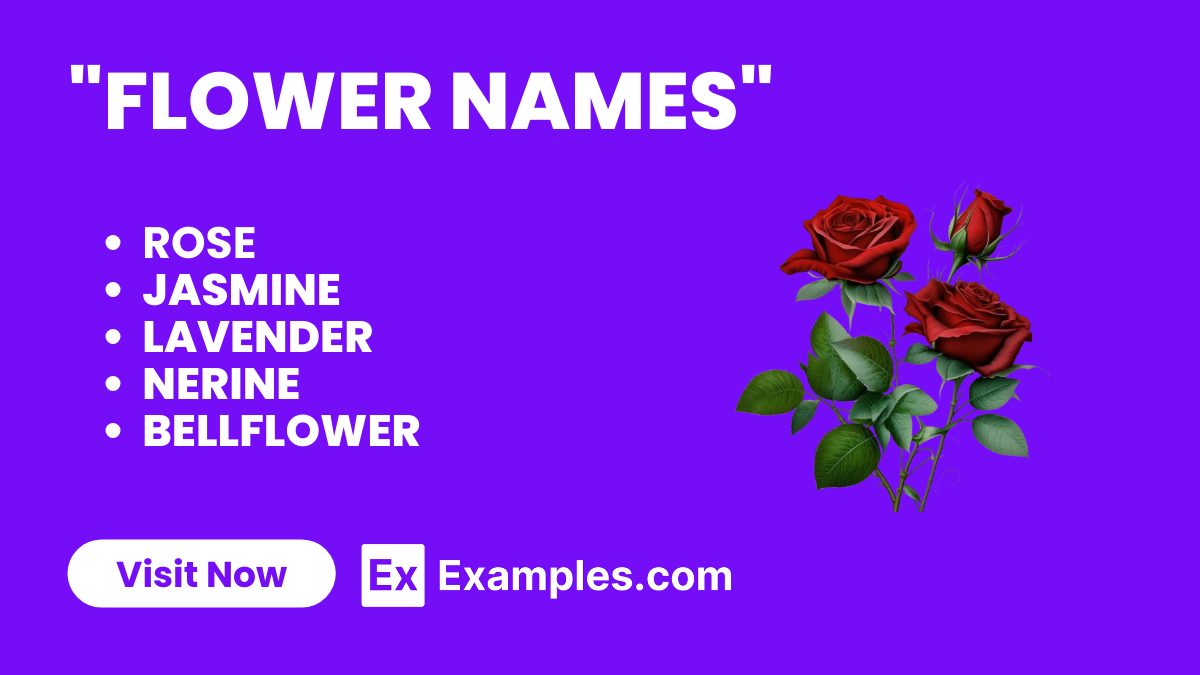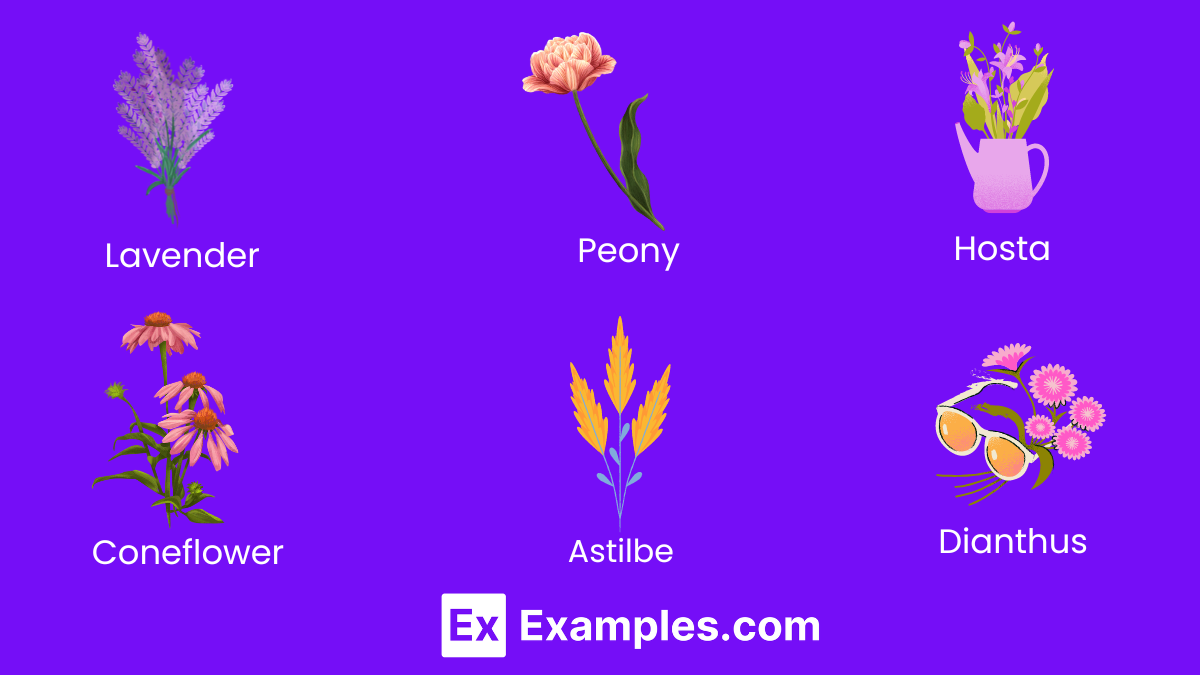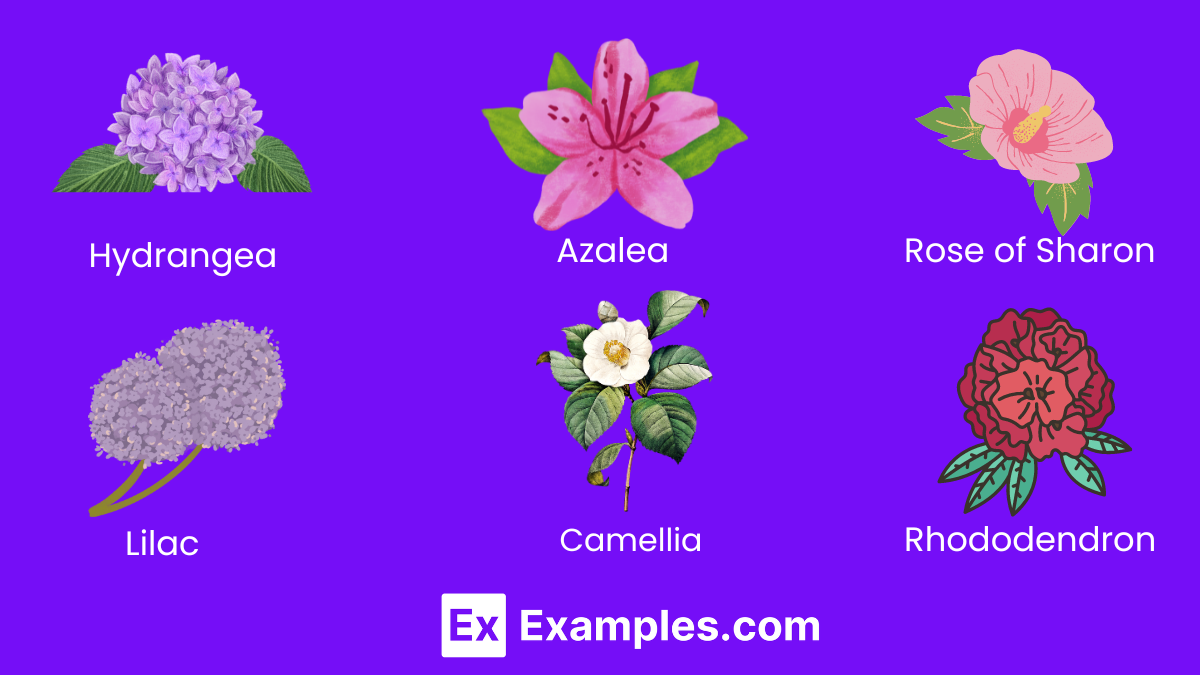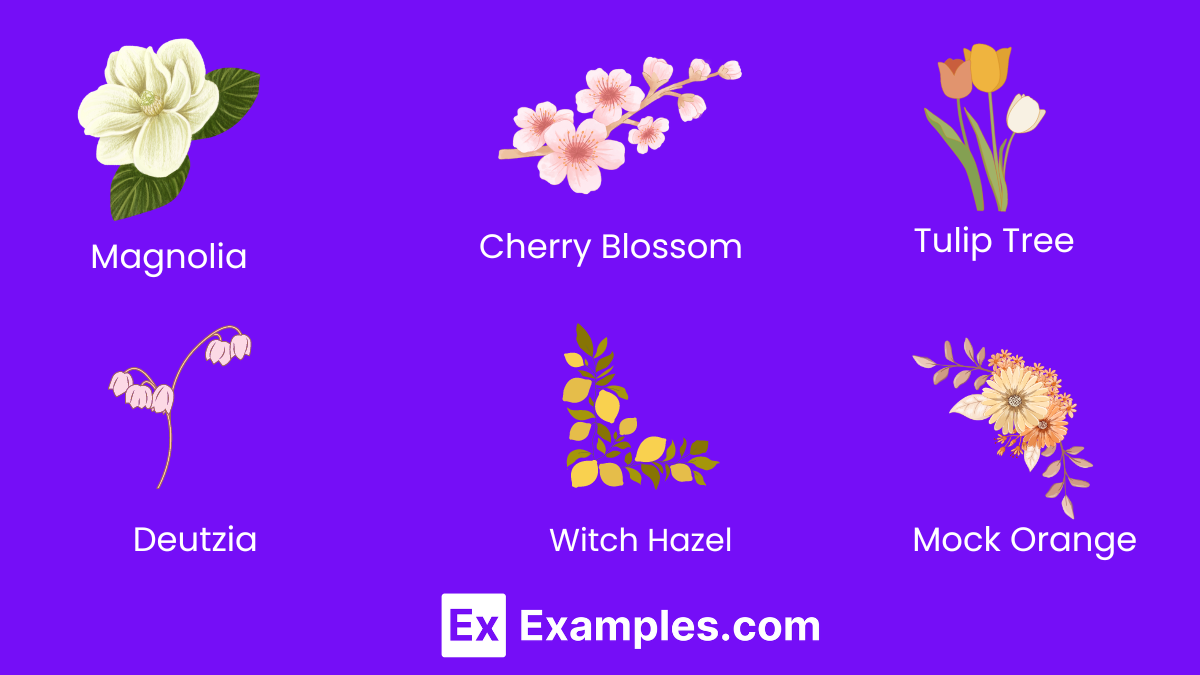100+ Flower Names: Meaning, Types, PDF
Dive into the enchanting realm of flora with our curated collection of flower names. From the delicate allure of the Daisy to the majestic presence of the Orchid, our compilation spans the spectrum of nature’s blossoms. Each name carries a unique story and symbolism, reflecting the diversity and beauty of the botanical world. Whether you’re a gardening enthusiast or seeking inspiration, this floral lexicon is your gateway to the vibrant tapestry of blooms that adorn our planet.
Download List of Flower Names - PDF
List of Flower Names
Embarking on a journey through the garden of nature’s masterpieces, we encounter the vast and vibrant world of flowers. Each bloom, from the delicate whispers of Jasmine to the robust vibrancy of Marigolds, tells a unique story of beauty, resilience, and evolution. Flowers are more than just visual delights; they are the essence of nature’s artistry, embodying diverse forms, colors, and fragrances. This rich tapestry of flora spans across various ecosystems, from the serene meadows adorned with Wildflowers to the exotic rainforests teeming with Orchids. The language of flowers, or floriography, has been a form of communication throughout history, conveying emotions, messages, and cultural symbols. In this comprehensive collection, we explore the myriad of flower names that capture the imagination and inspire the soul.
| Aconite | Begonia | Camellia | Dahlia |
| Edelweiss | Freesia | Gardenia | Hyacinth |
| Iris | Jasmine | Kalmia | Lavender |
| Magnolia | Nasturtium | Orchid | Peony |
| Quince | Rose | Sunflower | Tulip |
| Uva-Ursi | Verbena | Wisteria | Xeranthemum |
| Yarrow | Zinnia | Agapanthus | Bellflower |
| Calendula | Daffodil | Evening Primrose | Foxglove |
| Gladiolus | Honeysuckle | Impatiens | Jonquil |
| Kniphofia | Lilac | Marigold | Nerine |
| Osteospermum | Petunia | Queen Anne’s Lace | Ranunculus |
| Snapdragon | Thistle | Ursinia | Vetch |
| Wallflower | Xylobium | Yucca | Zephyranthes |
| Alyssum | Bougainvillea | Cosmos | Delphinium |
| Echinacea | Fuchsia | Gerbera | Hibiscus |
| Ixia | Jacob’s Ladder | Kerria | Lotus |
| Mimosa | Nigella | Oleander | Poppy |
| Quaking Grass | Rhododendron | Scabiosa | Trillium |
| Umbrella Plant | Vinca | Water Lily | Xanthosoma |
| Yellow Archangel | Zantedeschia | Amaryllis | Bird of Paradise |
| Candytuft | Dianthus | Eustoma | Forget-Me-Not |
| Gazania | Heather | Ipomoea | Joe-Pye Weed |
| Kangaroo Paw | Larkspur | Moonflower | Nemesia |
| Oxalis | Pansy | Quince | Rudbeckia |
| Salvia | Tansy | Ursinia | Violet |
| Waxplant | Xerophyllum | Ylang-Ylang | Zebra Plant |
| Aster | Black-eyed Susan | Chrysanthemum | Dusty Miller |
| Everlasting | Flax | Gypsophila | Hollyhock |
| Ice Plant | Juniper | Knautia | Lungwort |
| Monkshood | Nicotiana | Oleaster | Phlox |
| Queen’s Cup | Rockrose | Sweet Pea | Tuberose |
| Unicorn Plant | Valerian | Windflower | Xanthoceras |
| Yellow Bells | Zizia | Anemone | Bluebell |
| Carnation | Daisy | English Bluebell | Four O’Clock |
| Goldenrod | Hosta | Indian Paintbrush | Japanese Anemone |
| Knapweed | Love-in-a-Mist | Morning Glory | New Guinea Impatiens |
| Oxlip | Primrose | Quillaja | Rosemary |
| Saffron | Teasel | Upland Cotton | Veronica |
| Witch Hazel | Xiphium Iris | Yew | Zigzag Clover |
Different Types of Flowers
Flowering plants are of different types. According to their blooming cycles and plant types, they can be divided into different types. The categories of flowers include,
1. Annual Flowers
Annual flowers bring a burst of color and energy to gardens, completing their life cycle in just one year. From seeding to blooming and dying off, these vibrant beauties are perfect for adding seasonal charm. Ideal for educators looking to inspire creativity and teach the cycles of life through gardening.
- Marigold: Bright, cheerful flowers known for their vibrant orange and yellow hues.
- Petunia: Offers a rainbow of colors with its trumpet-shaped blooms.
- Zinnia: Features bold, round flowers that attract butterflies.
- Cosmos: Delicate, daisy-like flowers that come in various soft and striking colors.
- Sunflower: Iconic, large blooms that turn to follow the sun.
- Impatiens: Shade-loving flowers with a wide palette of colors.
- Pansy: Known for their charming faces, pansies come in multiple colors.
- Snapdragon: Tall spikes of brightly colored flowers, loved by children for their “snap”.
- Nasturtium: Edible flowers that add a peppery taste to salads.
- Lobelia: Small, vibrant flowers, excellent for hanging baskets and edges.
2. Perennial Flowers
Perennial flowers are the backbone of the garden, returning year after year. They establish long-lasting roots that bloom each season, offering sustainability and continuity in garden design. A fantastic tool for teaching about growth, endurance, and the changing seasons.
- Lavender: Fragrant, purple spikes that evoke calm and attract pollinators.
- Peony: Large, fragrant blooms in shades of pink, red, white, and yellow.
- Hosta: Known for its lush foliage and spikes of lavender or white flowers.
- Coneflower (Echinacea): Drought-tolerant with daisy-like flowers that attract butterflies.
- Black-eyed Susan: Bright yellow petals with a dark brown center; a pollinator favorite.
- Daylily: Striking flowers that bloom for just one day, in a variety of colors.
- Sedum (Stonecrop): Succulent leaves with clusters of star-shaped flowers.
- Astilbe: Feathery, plume-like flowers in shades of white, pink, and red.
- Dianthus: Pink, red, or white flowers with a spicy, clove-like fragrance.
- Russian Sage: Tall, with light blue flowers and silvery foliage, offering a cooling effect.
3. Biennial Flowers
Biennial flowers take two years to complete their life cycle, germinating and forming foliage in the first year and flowering in the second. They offer lessons in patience and the rewards of long-term care, ideal for educational environments fostering growth and development.
- Foxglove: Tall spikes of tubular flowers, often seen in woodland gardens.
- Hollyhock: Majestic towers of blooms, perfect for a backdrop in gardens.
- Sweet William: Clusters of fragrant flowers, ideal for cutting and bouquets.
- Verbena bonariensis: Verbena bonariensis is a biennial flowering plant valued for its tall, slender stems and clusters of small
- Lunaria: Lunaria, also known as honesty or silver dollar plant, is a biennial flower appreciated for its attractive purple or white flowers and papery seed pods.
- Bellflower :Bellflower is a biennial flowering plant known for its bell-shaped blooms.
- Biennial Phlox: Produces large, fragrant clusters of flowers in the second year.
- Evening Primrose: Yellow flowers that open at dusk and close by noon.
- Mullein: Tall, with yellow flowers along a single spike, and silvery foliage.
- Parsley (Petroselinum crispum): Often grown as an herb but flowers in its second year.
4. Shrub Flowers
Flowering shrubs add structure and multi-season interest to gardens, with some offering fragrant blooms, stunning foliage, and even fall color. They’re excellent for teaching about different plant forms and how they contribute to habitat diversity.
- Hydrangea: Large, ball-shaped flower clusters in shades of blue, pink, white, and green.
- Azalea: Part of the rhododendron family, with profuse, vibrant spring blooms.
- Forsythia: Bright yellow, early spring blooms that signal the arrival of spring.
- Lilac: Fragrant cone-shaped flowers, signaling the beginning of warm weather.
- Camellia: Glossy leaves with rose-like blooms in shades of pink, red, and white.
- Rhododendron: Large, leathery leaves with clusters of bell-shaped flowers.
- Weigela: Arching branches with trumpet-shaped flowers, attracting hummingbirds.
- Butterfly Bush (Buddleia): Long panicles of fragrant flowers that attract butterflies.
- Spiraea: Clusters of small, dainty flowers in white or pink.
- Rose of Sharon (Hibiscus syriacus): Late blooming with large, tropical-looking flowers.
5. Tree Flowers
Flowering trees bring a vertical element and spectacular blooms to landscapes, marking the seasons in educational settings and beyond. They can teach about the life cycle of trees, the importance of trees in ecosystems, and the sheer beauty of nature.
- Magnolia: Large, aromatic blooms that are among the first signs of spring.
- Cherry Blossom (Sakura): Iconic spring blooms that symbolize renewal and the fleeting nature of life.
- Dogwood: Delicate flowers with four petal-like bracts, symbolizing purity and rebirth.
- Deutzia: Deutzia is a shrub flower admired for its clusters of delicate, white or pink blossoms, adding charm to gardens and landscapes
- Witch Hazel: Witch Hazel is a shrub known for its spidery yellow or red flowers and its medicinal properties, commonly used in skincare products for its astringent qualities.
- Mock Orange: Mock Orange is a shrub with fragrant white flowers that resemble those of orange trees, adding a delightful aroma to gardens and landscapes.
- Pear: Similar to apple, with white spring blossoms followed by fruit.
- Tulip Tree: Named for its tulip-shaped flowers, providing nectar for pollinators.
- Southern Magnolia: Known for its large, creamy-white, and highly fragrant flowers.
- Jacaranda: Lavender, trumpet-shaped blooms that create a stunning floral display.
Flower Names for Girls
These flower names for girls are not only beautiful but also rich in symbolism and meaning, making them popular choices for parents seeking a name with natural elegance and depth.
| Flower Name | Origin & Meaning | Description |
|---|---|---|
| Lily | Latin; “purity, beauty” | Symbolizing purity and refined beauty, Lily is a timeless name associated with the elegant and serene lily flower. |
| Rose | Latin; “rose, a flower” | Rose is a classic name, representing the flower symbolizing love and beauty, cherished across cultures. |
| Daisy | Old English; “day’s eye” | Daisy is a cheerful and bright name, evoking the simple yet captivating daisy flower, symbolizing innocence. |
| Violet | Latin; “purple” | Named after the delicate purple flower, Violet conveys a sense of modesty, virtue, and affection. |
| Jasmine | Persian; “gift from God” | Jasmine is a sweet and romantic name, inspired by the fragrant white flowers known for their intoxicating scent. |
| Ivy | Old English; “faithfulness” | Ivy, representing fidelity and eternity, is a name that brings to mind the evergreen climbing vine, symbolizing growth and connection. |
| Poppy | Latin; “red flower” | Poppy is a vibrant and spirited name, reflecting the bright red flower associated with remembrance and peace. |
| Iris | Greek; “rainbow” | Iris, carrying connotations of wisdom and valor, is named after the colorful flower symbolizing hope and courage. |
| Heather | English; “heather plant” | Heather is a name inspired by the resilient and enduring heather plant, known for its purple blooms that cover the Scottish moors. |
| Azalea | Greek; “dry” | Azalea, suggestive of femininity and softness, is named after the vibrant and hardy spring flower, symbolizing temperance and passion. |
Flower Names for Boys
These names draw inspiration from the botanical world, offering unique and meaningful options for naming boys with a connection to nature and its timeless beauty.
| Flower Name | Origin & Meaning | Description |
|---|---|---|
| Aster | Greek, meaning “star” | Represents love, wisdom, and faith; star-shaped blooms in various colors. |
| Benton | Old English, “bent grass settlement” | Not directly a flower, but associated with natural elements and greenery. |
| Florian | Latin, “flowering” | Derived from Roman mythology, symbolizing blossoming and flourishing. |
| Jared | Hebrew, “rose” | Connotes the beauty and elegance of a rose, symbolizing love and appreciation. |
| Kunal | Sanskrit, “Lotus” | Represents purity and enlightenment, named after an ancient Indian sage. |
| Ren | Japanese, “lotus” | Symbolizes purity and rebirth, often used in a peaceful and calming context. |
| Sorrel | French, “sour”, related to the Sorrel plant | Associated with a tangy, vibrant green plant, reflecting nature and vitality. |
| Valerian | Latin, “to be strong” | Named after a plant with small, sweet-smelling flowers, symbolizing strength and resilience. |
| Yarrow | Old English, derived from the yarrow plant | Represents healing and protection, known for its medicinal properties. |
| Zephyr | Greek, “west wind”, associated with Zephyranthes | Refers to a gentle breeze and delicate flowers, symbolizing nature’s subtle beauty. |
Is learning the names of flowers important for students?
Learning the names of flowers is important for students for several reasons, contributing to their educational development and personal growth in various ways:
- Botanical Knowledge: Understanding flower names enhances students’ botanical knowledge, helping them recognize the diversity of plant life and understand ecological relationships.
- Cultural and Historical Context: Many flowers have historical and cultural significance. Learning their names can provide insights into different cultures and historical periods, fostering a broader worldview.
- Language and Literacy: Learning flower names can enrich students’ vocabulary and language skills, introducing them to descriptive language and new terms.
- Scientific Inquiry: Knowing flower names encourages curiosity and scientific inquiry, prompting questions about plant biology, reproduction, and the role of flowers in ecosystems.
- Art and Aesthetics: Flowers are often subjects in art and literature. Recognizing different flowers can enhance students’ appreciation of art and literature, allowing them to understand and interpret botanical imagery.
- Environmental Awareness: Recognizing flowers can foster a deeper appreciation for nature and the environment, promoting conservation awareness and a sense of responsibility towards protecting natural habitats.
- Mindfulness and Well-being: Learning about flowers can also have therapeutic benefits, promoting mindfulness, and well-being through nature connection.
- Practical Skills: Knowledge of flowers can be practical in various hobbies and interests, such as gardening, floral design, and photography.
List of Flower Names A-Z
Flower Names Starting with A
| Flower Names | Flower Names |
|---|---|
| Amaryllis | Anemone |
| Aster | Azalea |
| Alstroemeria | Agapanthus |
| Alyssum | Acacia |
| Angelonia | Allium |
Flower Names Starting with B
| Flower Names | Flower Names |
|---|---|
| Begonia | Bluebell |
| Buttercup | Baby’s Breath |
| Bellflower | Bird of Paradise |
| Bougainvillea | Black-eyed Susan |
| Blazing Star | Bleeding Heart |
Flower Names Starting with C
| Flower Names | Flower Names |
|---|---|
| Chrysanthemum | Cosmos |
| Carnation | Calla Lily |
| Clematis | Camellia |
| Coreopsis | Columbine |
| Crocus | Calendula |
Flower Names Starting with D
| Flower Names | Flower Names |
|---|---|
| Dahlia | Daffodil |
| Daisy | Delphinium |
| Dianthus | Dusty Miller |
| Dutch Iris | Dandelion |
| Dogwood | Dracaena |
Flower Names Starting with E
| Flower Names | Flower Names |
|---|---|
| Echinacea | Edelweiss |
| English Daisy | Evening Primrose |
| Eustoma | Erica |
| Euphorbia |
Flower Names Starting with F
| Flower Names | Flower Names |
|---|---|
| Foxglove | Freesia |
| Fuchsia | Forget-Me-Not |
| Flax | Feverfew |
| Flame Lily | Filbert |
| Frangipani | Fairy Bell |
Flower Names Starting with G
| Flower Names | Flower Names |
|---|---|
| Gardenia | Geranium |
| Gladiolus | Gypsophila |
| Gazania | Goldenrod |
| Gloxinia | Gerbera Daisy |
| Godetia | Guzmania |
Flower Names Starting with H
| Flower Names | Flower Names |
|---|---|
| Hibiscus | Hydrangea |
| Hellebore | Heliotrope |
| Hollyhock | Heather |
| Hyacinth | Honeysuckle |
| Hosta | Hypericum |
Flower Names Starting with I
| Flower Names | Flower Names |
|---|---|
| Iris | Impatiens |
| Ice Plant | Indian Paintbrush |
| Iberis |
Flower Names Starting with J
| Flower Names | Flower Names |
|---|---|
| Jasmine | Jonquil |
| Jacob’s Ladder | Joe-Pye Weed |
| Japanese Anemone | Jewelweed |
Flower Names Starting with K
| Flower Names | Flower Names |
|---|---|
| Kangaroo Paw | Kniphofia |
| King Protea | Kerria |
| Kalmia | Knautia |
| Kalanchoe | Kiss-me-over-the-garden-gate |
| Kentucky Coffeetree | Kaffir Lily |
Flower Names Starting with L
| Flower Names | Flower Names |
|---|---|
| Lily | Lavender |
| Lupine | Lantana |
| Lilac | Lotus |
| Lobelia | Liatris |
| Love-in-a-mist | Lady’s Mantle |
Flower Names Starting with M
| Flower Names | Flower Names |
|---|---|
| Marigold | Magnolia |
| Morning Glory | Monkshood |
| Myrtle | Mimosa |
| Moonflower | Mums (Chrysanthemum) |
| Milkweed | Meadowsweet |
Flower Names Starting with N
| Flower Names | Flower Names |
|---|---|
| Nasturtium | Narcissus |
| Nigella | Nerine |
| Nicotiana | Nymphaea |
| Ninebark | Nepeta |
| New Guinea Impatiens | Night-blooming Cereus |
Flower Names Starting with O
| Flower Names | Flower Names |
|---|---|
| Orchid | Oxalis |
| Oleander | Osteospermum |
| Ornamental Onion | Orange Blossom |
| Osmanthus |
Flower Names Starting with P
| Flower Names | Flower Names |
|---|---|
| Peony | Petunia |
| Pansy | Poppy |
| Primrose | Plumeria |
| Phlox | Protea |
| Pulmonaria | Passion Flower |
Flower Names Starting with Q
| Flower Names | Flower Names |
|---|---|
| Queen Anne’s Lace | Quince Blossom |
Flower Names Starting with R
| Flower Names | Flower Names |
|---|---|
| Rose | Rudbeckia |
| Ranunculus | Rhododendron |
| Rosemary | Rockrose |
| Russian Sage | Rafflesia |
| Rose of Sharon | Ragged Robin |
Flower Names Starting with S
| Flower Names | Flower Names |
|---|---|
| Sunflower | Snapdragon |
| Sweet Pea | Snowdrop |
| Sedum | Salvia |
| Statice | Scabiosa |
| Strelitzia (Bird of Paradise) | Shasta Daisy |
Flower Names Starting with T
| Flower Names | Flower Names |
|---|---|
| Tulip | Thistle |
| Tiger Lily | Trillium |
| Tansy | Teasel |
| Torenia | Trumpet Vine |
| Tagetes | Tuberose |
Flower Names Starting with U
| Flower Names | Flower Names |
|---|---|
| Ursinia | Uva-Ursi |
Flower Names Starting with V
| Flower Names | Flower Names |
|---|---|
| Violet | Verbena |
| Vinca | Vetch |
| Virginia Bluebell | Viburnum |
| Valerian | Vanilla Orchid |
| Vanda Orchid |
Flower Names Starting with W
| Flower Names | Flower Names |
|---|---|
| Wisteria | Wallflower |
| Water Lily | Wax Plant |
| Windflower | Wild Rose |
| Witch Hazel | Winter Jasmine |
| Wood Anemone | Woolly Thyme |
Flower Names Starting with X
| Flower Names | Flower Names |
|---|---|
| Xeranthemum | Xylobium |
Flower Names Starting with Y
| Flower Names | Flower Names |
|---|---|
| Yarrow | Yellow Archangel |
| Yucca | Yellow Bell |
| Yellow Iris | Ylang-Ylang |
| Yellow Jessamine | Yew |
| Yellow Loosestrife |
Flower Names Starting with Z
| Flower Names | Flower Names |
|---|---|
| Zinnia | Zephyranthes |
| Zigzag Clover | Zantedeschia |
| Zenobia | Zebra Plant |
In conclusion, the world of flower names is as diverse and colorful as the blooms themselves, offering a rich tapestry of meanings, origins, and stories. From the classic Rose to the exotic Zephyranthes, each name carries a unique essence, reflecting the beauty and complexity of nature. These names not only adorn our gardens but also enrich our language and cultural heritage.








